 | |||
|
| Home > Public Information > ING Annual Reports > 2004-2005 > In-House Research |
Previous: Use of Observing Time and Scientific Productivity | Up: Table of Contents | Next: Public Relations
Other available formats: PDF
In-House Research
The in-house research effort at ING comprises 1 full-time equivalent (FTE)
from its recurrent operational budget, an additional 2 FTEs contributed by
PPARC. This effort is distributed amongst 9 members of the Astronomy Group
which includes the Head of Astronomy, 6 support astronomers and 2 PPARC research
fellows. In addition to these staff there is an additional research astronomer
(Dr. Evans) funded through a PPARC Postdoctoral research grant award to Dr.
Lennon.
During the years 2004 and 2005, ING staff's research productivity, as measured
by publication rate was maintained at its previous high level, publishing
approximately 200 papers in various scientific publications, approximately
50% of these appearing in refereed journals. A complete list of these papers
is included in Appendix F. As in previous years, an important aspect of the
research effort is that ING staff continue to be closely involved with on-going
research programmes which are heavily dependent on observations carried out
on our telescopes. An important example of this synergy is ING’s very
active role in the INT/WFC Hα survey of the north Galactic plane (the
IPHAS survey, PI: Prof. Drew), which involves 6 ING staff (Corradi, Greimel,
Lennon, Leisy, Skillen and Evans) and makes use of their expertise with the
Wide Field Camera, for the survey, and with AF2, for the spectroscopic follow-up.
An excellent example of collaboration with other facilities on the Roque de
Los Muchachos Observatory is typified by Ian Skillen’s involvement with
the SuperWASP facility, this project kicked off in 2004 and aims to carry
out an ultra-wide-angle survey of the northern sky. In addition Licandro co-ordinated
a multi-telescope monitoring campaign focused on Deep Impact, more of these
and other activites are discussed below.
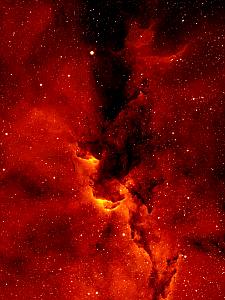 |
|
Figure 54. IC1396, the Elephant Trunk Nebula, is
a giant cloud of gas and dust is illuminated by a massive central
star whose radiation is triggering star formation throughout the region.
This image was obtained as part of the IPHAS survey. Field of view
is approximately 15×20 arcmin, North to the left, East is down
[ JPEG | TIFF
].
|
Individual Research Activities
Benn investigated the properties of the most radio-luminous broad-absorption-line (BAL) quasar known (1624+3758), discovered during his earlier INT search for high-redshift radio quasars. The quasar is highly unusual, with prominent FeII UV191 1787-A emission, a broad detached BAL trough, and the second-largest radio rotation measure known. This suggests that the quasar is intrinsically unusual (probably due to an exceptionally high accretion rate and also a high Eddington ratio), rather than merely viewed at an unusual angle, as has often been posited to explain the peculiar properties of BAL quasars. This work was carried out in collaboration with Carballo and González (Santander), Holt (Sheffield), Vigotti and Mack (Bologna), and Perley (NRAO). He also co-supervised (with Ellison, Victoria, Canada) an investigation by Russell (1-year student at ING) into quasar damped-Ly-α absorbers (DLAs), finding that there is an excess at low velocities (v<6000 km s-1) relative to the quasars, i.e. the properties of the DLAs can be used to constrain clustering near high-redshift quasars.
In collaboration with Furness (1-year ING student), Schirmer (ING) and Sánchez (Calar Alto), Benn obtained a sample of z~4.5 Ly-α galaxies from a deep imaging search at the INT. This is the first stage of a search for the expected dramatic decline in galaxy counts marking the epoch of re-ionisation.
Sánchez and Benn published an analysis of astronomical productivity by country (a follow-up to their earlier analysis of the scientific productivities of telescopes worldwide).
Corradi studied several aspects concerning Galactic and extragalactic planetary nebulae (PNe). A significant result was the detection of systems of concentric rings around the main bodies of the nebulae (previously known only in few PNe) around a large fraction of the PNe that were properly imaged. This implies that the mass loss modulation producing the rings in the last 10,000–20,000 years of the AGB evolution must be a rather ubiquitous phenomenon, and therefore should be included in any physical model describing the critical mass loss that takes place in this phase.
A thourough study of the dynamics of the multi-polar nebula Mz3 was performed, showing an enigmatic system of 4 distinct outflows with different degrees of collimation. At present, none of the existing theories can explain such a complex mass loss behaviour from an evolved star.
Concerning extragalactic PNe, their search using the observation from the Local Group Census survey was nearly completed, and follow-up spectroscopy with the aim of determining their chemical properties was presented for the nearby spiral galaxy M33. This extends our knowledge of the galaxy’s chemical content at intermediate ages of its evolution.
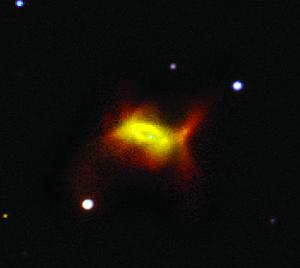 |
Greimel has worked with Augusteijn (NOT) on the selection of red dwarf-white dwarf binaries from the SDSS. He is also involved in the Hα survey of the Milky Way (IPHAS) and its follow up observations. Together with Corradi (ING), Viironen and Mampaso (both IAC) he participated in the compact PN search; together with Steeghs (CfA), Drew and Unruh (both ICL) he defined the Hectospec and AF2 follow up observations. He also defined the IPHAS variable star candidate list of which follow up observations have started in collaboration with Robb (Victoria, Canada).
Lennon, together with Evans (postdoc) and Trundle (PhD student) completed the most definitive study to date of massive star wind terminal velocities in the Small Magellanic Cloud. This work was based on extensive allocations of HST/STIS observing time, and the same data were used to present a comprehensive atlas of ultra-violet spectra of metal-poor massive stars. The use of this atlas for synthesizing the UV spectra of high-redshift star forming galaxies was also a highlight of this project (in collaboration with Rix), as was its use to investigate the nature of the super star clusters in NGC1705-1.
Trundle & Lennon published a comprehensive study of B-type supergiants in the Small Magellanic Cloud, uncovering a serious discrepancy between observed and theoretical mass-loss rates with important implications for our understanding of mass-loss in luminous blue variables, and the physics of mass-loss in these kinds of stars. They also also found very high surface nitrogen abundances in these stars, typical enhancements being an order of magnitude higher than the pristine SMC nitrogen abundance.
Evans published the first results of a 2dF survey of massive stars in the Small Magellanic Cloud, this seminal paper providing a rich dataset comprising 4161 spectra, mostly of B and A giants/supergiants. He has also published several core papers on detailed analyses of massive OB stars in the Magellanic Clouds which were instrumental in revising their effective temperature scale. Lennon & Evans also spent considerable time working on the ‘VLT-FLAMES Survey of Massive Stars’, a Large VLT project which will ultimately produce, as part of its brief, detailed analyses of approximately 1000 OB stars in the Galaxy and the Magellanic Clouds. Evans is the lead author on the first two consortium papers submitted to A&A, while there are several other papers in preparation or already submitted.
Evans and Lennon also continued their involvment in large scale spectroscopic surveys with contributions to the IPHAS follow-up spectroscopy, completing the preliminary classification of several thousand spectra in selected IPHAS fields (with student intern Mansura Jaigirdar), and contributed to the formulation of a large programme aimed at surveying the Magellanic Clouds.
Rix has published a pioneering paper that promotes the use of new metallicity indicators, based on iron absorption features, for measuring the chemical enrichment of high redshift star-forming galaxies. This work was based mainly on theoretical synthetic spectra, and she has now turned her attention to applying them to observed spectra. Rix has also pursued her work on quasar absorption line systems. In 2004 she was the co-author on a paper that quantified the possible impact of dust from intervening galaxies on QSO absorber statistics.She is now collaborating with Pettini (IoA) in a project to study the detailed physical and chemical properties of a proximate damped Ly-α absorber.
In her role as ‘XOasis support’ for the ING’s OASIS instrument, Rix is also involved in a research project with Lennon and Parker (1-year ING student) to study the circumstellar properties of the Luminous Blue Variable (LBV) P Cygni. This project exploits adaptive-optics 3D spectroscopic observations from the WHT’s OASIS +NAOMI instrumentation suite.
Leisy continued his study of extragalactic planetary nebulae (PNe). He published two articles about new PNe candidates in Local Group (LG) Galaxies and one about the abundance determinations of 180 PNe in the LMC and SMC. A search for fainter PNe, hopefully also very metal poor, has been started in the SMC and the bar of LMC, as well as in other Local Group galaxies with the Local Group Census survey (with the WFC and the ESO 2.2m WFI).
Many new candidates have been found in several galaxies, and most of them are already spectroscopically confirmed. The main goal is to produce catalogs of emission line objects, and then to do spectroscopic follow-up, mainly of PNe and HII regions. The main goals are to determine abundances and to confirm membership of some of the candidates lying very far away from their parent galaxy centers (with high resolution spectroscopy at the WHT/AF2 for example). Four Local Group galaxies (Sextans A and B, IC1613 and NGC3109) have also been observed with the VLT/FORS2 and and time was awarded on Gemini North to observe some additional northern galaxies.
These spectra are used to derive chemical abundances, both to better understand the stellar evolution of intermediate mass stars and the chemical evolution of galaxies in the Local Group and beyond. The very important effects of nuclear processes at low metallicity will help to better constrain what happened during the first stages of the formation of the first galaxies.
Licandro carried out a spectral (visible and near-infrared) survey of trans-neptunian objects (TNOs) and related icy minor planets, and also studied the physics of cometary comae. He was also the P.I. of the international campaign at the ORM in support of the Deep Impact mission. Comet 9P/Tempel 1 was observed for several months before the impact with the TNG, and during 10 days around the impact, from July 2 to July 10, was observed simultaneously with the WHT, TNG and NOT telescopes. Images in the visible and near-IR low and high resolution spectra in the visible and near-IR, were obtained. The data, still under analysis, offer a unique opportunity to study the properties of the dust ejected by the impactor (amount of dust ejected, size distribution, etc), and to study also the gas produced after the impact.
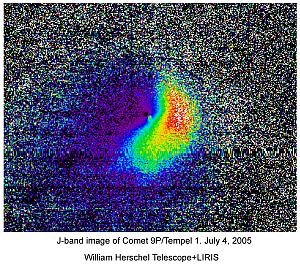 |
|
Figure 56. J-band image of comet Tempel 1 obtained
using LIRIS on the WHT on July 4th, 2005. The image is the division
of July 4th by July 3rd images. A clear jet structure is visible in
South-West direction (on the image, North is up, East is left). The
field of view of the image is 50×50 arseconds on sky which corresponds
to about 32,000 kilometres at the distance of the comet [ JPEG
| TIFF ].
|
The visible and near-IR spectra of several TNOs, Centaurs and comet nuclei were obtained during 2004-2005. Particularly important is the discovery that the surface of TNO 2005 FY9, the third largest known TNO, is very similar to that of Pluto. The spectrum is dominated by the strong methane-ice absorption bands. The observed bands are deeper than those in Pluto's spectrum, which is indicative of a larger fraction of methane-ice and/or methane-ice with larger particle size in the surface of this bright TNO. This study reveals that 2005 FY9 is an excellent candidate to be the second. known TNO with a bound atmosphere (Pluto is until now the only case of a TNO with atmosphere).
Other important results are those revealed by the study of the spectrum of TNOs Quaoar and 2002 TX300, using scattering models. Both large TNOs present interesting surface properties. Quaoar presents a large fraction of cristaline water-ice on the surface, and clear indications of other volatiles, probably methane-ice. 2002 TX300 present the strongest ever observed water ice absorption bands, it spectrum is similar to that of Charon. This is the first Charon-like TNO observed. The spectra of all these large TNOs reveal that their study is very important to understand the resurfacing processes that make that large TNOs exhibit fresh volatiles in their surface.
Méndez and colleagues completed the search for the companion star to Tycho SN 1572, which followed the publication of a paper in Nature (P. Ruiz-Lapuente et al., 2004, Nature, 431, 1069). The research team found a subgiant star, named as 'Tycho G', whose proper motion was too high for its Galactic location and in the range of the expected gained momentum at the supernova time. This and other features led the discovery team to conclude that Tycho G was the companion star to Tycho SN at the time of the explosion. Méndez also continued to participate in observations for and preparation of papers by the Supernova Cosmology Project, the Physics of Type Ia Supernova Explosions (RTN) and the European Supernova Consortium (ESC) collaborations. He also researched the history of the ING, and participated in the organisation of several international conferences and in public outreach activities.
Østensen is continuing his work with the ING Adaptive Optics group, where his work has focused on characterisation of AO performance. In his research he has continued his ongoing work on pulsations in subdwarf B-type stars, discovering a number of new pulsators as well as several interesting short period binary sdB+dM systems (in collaboration with Solheim, Oslo and Oreiro, IAC). In collaboration with Telting (NOT) he has presented the first evidence of line profile variations in an sdB star from time resolved spectroscopy. He has also undertaken a survey of spectroscopic subdwarf B binaries with NAOMI in order to put the different evolutionary scenarios proposed for these stars to a test.
Other projects in this field include mining the Sloan Digital Sky Survey for spectroscopic and photometric data on new and known subdwarf stars, and spectroscopic model fitting of sdB stars and sdB stars in binary systems (with Heber, Bamberg).
Østensen has continued to develop a complete database system for hot subdwarf stars, bringing together results from the numerous blue star surveys into one searchable databank that has now been released for public use. Østensen also organized the 2nd Meeting of Hot Subwarf Stars on La Palma during 2005.
Schirmer continued his work on the selection of galaxy clusters using weak gravitational lensing techniques. Such a mass-selected sample of galaxy clusters is of great cosmological interest, since clusters of galaxies indicate the highest dark matter density peaks in the Universe, and therefore retain a memory of the initial conditions for structure formation. From a 20 square degree survey 30 candidate galaxy clusters have been selected, and Mischa applied for multi-object spectroscopy time for further detailedinvestigation. If confirmed, these clusters will form the currently largest sample of mass-selected dark matter haloes. The main collaborators in this project are Matturi (Padova), van Waerbeke (UBC Vancouver) and Schneider (Bonn). The same survey data forms the basis of several other projects Mischa is involved in, such as studies of the dark matter haloes of galaxies (Kleinheinrich et al.), populations of Lyman-break galaxies at various redshifts (Hillebrandt et al.), the galaxy dark matter bias (Simon et al.) (all University of Bonn), or a census of tidal tails (Pohlen et al., IAC).
Within the framework of ING, Leisy and Schirmer are searching for planetary nebulae in Local Group galaxies and beyond, significantly improving their detection efficiency by means of sophisticated data reduction schemes. Together with Chris and Furness he participates in the search for Lyman-break galaxies at redshifts of 4 and beyond. Other of his projects encompass the identification of unknown gamma-ray sources in the Galaxy (La Palombara et al., Milan), X-ray emitters in NGC 300 (Carpano, Tübingen) and the search for the missing mass of the Crab Supernova remnant, which has been an unsolved mystery for more than two decades. Deep Hα images have recently been obtained by Lundqvist et al., and first results look very promising.
Skillen in a collaboration with Pollacco and Todd (QUB), Bell (RAL) and Augusteijn (NOT), is conducting an ongoing photometric search for eclipsing binary systems in local group galaxies. Approximately one hundred new systems have been discovered in each of M31, IC 1613 and NGC 6822. Selected systems will be followed up spectroscopically to determine accurately their physical parameters and hence distances. The goal of this project is to investigate the impact of the physical environment on standard candles within the Local Group, and to reduce the uncertainty in the determination of the Hubble Constant to within 5%.
The SuperWASP facility was inaugurated and fully commissioned in 2004, in collaboration with Pollacco (QUB) and the WASP Consortium. The WASP project is an ultra-wide-angle photometric survey with a precision of better than 1% of stars in the magnitude range 7–13, with the primary goal of discovering exosolar planet transits. It will also provide an unrivalled census of variable stars over the northern sky; the resulting archive will be exploited for a variety of science goals, ranging from the discovery of exosolar planets to aspects of stellar pulsation, binarity and galactic structure. A programme, in collaboration with Barnes (Texas), to determine high precision (0.4 km s-1) radial velocity curves of galactic Cepheid stars from echelle spectroscopy, has now been completed.
Scientific Conferences
Rutten organized the 'Workshop on Adaptive-Optics Assisted Integral-Field Spectroscopy' at the Hotel H10 Taburiente Playa in Los Cancajos on La Palma during May 9–11 2005. Integral-field spectroscopy and Adaptive Optics (AO) techniques are an increasingly important tool in astronomy. A number of integral-field spectrographs are in operation around the world, and AO instruments are proliferating and becoming a standard feature of in particular the largest ground-based telescopes. The combination of integral-field spectrographs and AO is still a relatively unexplored area where the potential benefits for astronomy are huge. For that reason, a number of projects are under way or are being proposed that will take advantage of the most recent technological developments in these areas. The most prominent scientific prospects are expected to be in the areas of study of the dynamics of the central regions of elliptical galaxies and active galactic nuclei, spectroscopy of gravitationally lensed high-redshift galaxies, star formation regions and outflow of evolved stars, and the dynamics of crowded stellar fields.The advent of a new facility instrument at the 4.2m William Herschel Telescope, the OASIS Integral Field Spectrograph, working in conjunction with the NAOMI AO system prompted the holding of a workshop covering this area. Moreover, the ING laser guide star facility (GLAS) which is currently under development, will open up nearly the full sky to AO exploitation. This implies a huge new potential for AO assisted spectroscopy to be carried out on large samples of objects, as there no longer will be the restriction of having to have a nearby bright guide star.
The workshop focused on the scientific achievements and prospects of AO-assisted integral field spectroscopy, promoting discussion and sharing of experiences and ideas. The outcome prompted new collaborations and ideas for observing programmes, while at the same time it provides the observatory with scientifically inspired advice on how to maximally exploit the exciting possibilities of AO at the William Herschel Telescope. The proceedings were published in Rutten, R. G. M., Benn, C. R., Méndez, J., 2006, New Astronomy Reviews, 49, 487.
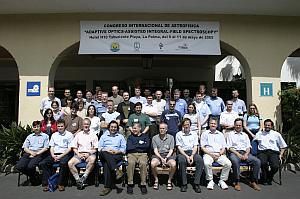 |
Østensen organized the '2nd Meeting on Hot Subdwarf stars and related objects' at the Real Club Náutico de Santa Cruz de La Palma during June 6–10 2005, a collaborative venture between the ING and NOT. Hot subdwarf stars are extreme horizontal branch (EHB) stars and pre-white dwarf stars. The EHB stars are core helium-burning stars with extremely thin hydrogen envelopes, and form the majority of bright stars in surveys for extremely blue objects, where they are classified as subdwarf-B (sdB) stars. They also appear in the colour-magnitude diagrams of some globular clusters as an extension of the blue tail formed by classical horizontal branch stars, though it is not clear why some clusters show this feature and other do not. The pre-white dwarf stars are related to the sdBs, but have exhausted their capacity to burn helium in the core. Many of the brightest hot subdwarfs in the field are of this class, and they are classified as sdO stars.
Hot subdwarf stars and their relatives are believed to be important contributors to the hitherto mysterious UV upturn phenomenon in early-type galaxies; and a comprehensive investigation on this issue is being performed by the Galaxy Evolution Explorer (GALEX). The formation of EHB stars remains, in general, a matter of debate. Recent results for Galactic EHB stars show that the majority are close binary stars, so mass transfer and mass loss due to interactions between the stars clearly play a role. EHB stars are an excellent tool for studying evolution in close binary stars. Some EHB stars shows p-mode pulsations with periods of a few minutes and some others show g-mode pulsations with periods on the order of hours. Asteroseismology can be used to measure fundamental parameters for these stars directly. Hot subdwarf stars are also a laboratory for studying the effects of diffusion, weak stellar winds, radiative levitation and gravitational settling. These processes are seen to affect the peculiar composition of their atmospheres and also play a role in the driving mechanism for pulsations and, perhaps, the subsequent evolution of the star.
The meeting was divided into sessions that covered a broad range of topics related to the hot subdwarf stars. They were: evolutionary models and the UV-upturn phenomenon; hot subdwarfs and hot HB stars in the field, clusters and galaxies; atmospheric properties of hot subdwarf stars; hot subdwarfs in binary systems; asteroseismology of sdB stars.
Eight half day sessions were completed during the meeting, with three sessions dedicated to asteroseismology, two sessions for atmospheric properties and the remaining topics filling one session each. 58 participants from all over the world attended the meeting, almost half again as many as at the first meeting. The proceedings are to be published in journal Baltic Astronomy, Volume 15.
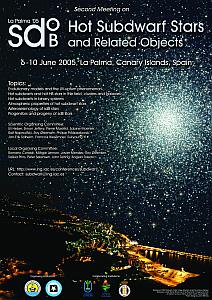 |
Danny Lennon organized a Royal Astronomical Society Specialist Meeting 'Science from La Palma —Looking Beyond 2009' in collaboration with Evans (ING) and Drew (ICL). The meeting was held at Burlington House, Piccadilly, London, on 14 October 2005. In 2009 the international agreement setting up the Roque de los Muchachos Observatory on the island of La Palma will have been in existence for a period of 30 years. In the near future the United Kingdom will have to make a decision on whether or not to withdraw from that agreement and PPARC, through its ownership of the Isaac Newton Group of Telescopes, has the responsibility of deciding on the UK's involvement in the observatory beyond 2009. As part of the decision making process, and in support of the UK's overall strategic re-evaluation in astronomy, the ING was reviewed during 2005. It was therefore thought timely to assess recent scientific achievements from the Roque de los Muchachos, and to consider what role the observatory might have beyond 2009. The meeting was attended by approximately 100 astronomers from around the UK, and was structured to allow two morning sessions of science talks with contributors from various fields in astronomy. This was followed in the afternoon by a series of strategy talks, culminating in a half-hour discussion on the future of the ING.
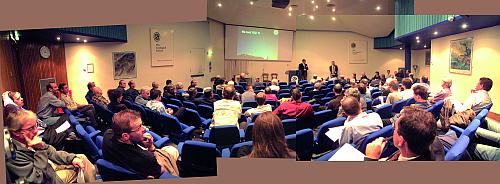 |
| Top | Back |
|

